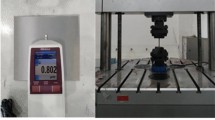Abstract
In this study, fatigue life assessment was conducted on a KC-1 membrane, considering cryogenic operation temperature, effect of stamping, and very long service period. KC-1 membranes are produced through a process of stamping, and they make direct contact with LNG filled within a containment system at − 162 °C. The high waves that LNG carriers encounter during sailing, and even when at anchor, cause rolling motions of the hull, which result in resonant fluid motions that generate a sloshing phenomenon; such sloshing motions expose containment systems to a high level of repeated stress. To assess the very high cycle fatigue (VHCF) life of the membrane, the effects of plastic deformation and the mechanical properties of STS304L, a membrane material, were examined at cryogenic temperatures. To identify the effects of plastic deformation and cryogenic temperatures on their mechanical properties, tensile and VHCF tests were conducted at cryogenic temperatures on a sheet to which plastic strain was applied through cold-rolling. Through forming analysis, changes in the thickness and plastic strain of a membrane caused during the process of stamping were examined. The results of earlier studies that performed flow analysis and fluid–structure interaction analysis to measure the stress applied to each component of the KC-1 containment system were cited, and the VHCF life of the membrane was assessed based on the surveyed mechanical properties, and the results of forming analysis.












Similar content being viewed by others
References
Gavory, T., & de Seze, P. E. (200). Sloshing in membrane LNG carriers and its consequences from a designer’s perspective. In Proceedings of the 19th interernational offshore and polar engineering conference, Osaka, Japan.
Wang, K. S. (2010). Loss prevention through risk assessment surveys of LNG carriers in operation, under construction, conversion and repair. Tokyo: BMT Marine & Offshore Surveys.
Jin, K. K., Yoon, I. S., & Yang, Y. C. (2015). An effect of surface dashpot for KC-1 basic insulation system under sloshing loads. Transactions of the Korean Society of Mechanical Engineers C,3, 193–199.
Lee, C. S., Cho, J. R., Kim, W. S., Noh, B. J., Kim, M. H., & Lee, J. M. (2013). Evaluation of sloshing resistance performance for LNG carrier insulation system based on fluid-structure interaction analysis. International Journal of Naval Architecture and Ocean Engineering,5, 1–20.
Cho, J. R., Park, S. W., Kim, H. S., & Rashed, S. (2008). Hydroelastic analysis of insulation containment of LNG carrier by global-local approach. International Journal for Numerical Methods in Engineering,76, 749–774.
KS B0801. (1981). The pieces for tension test for metallic materials. Korean Industrial Standards.
Bathias, C., & Paris, P. C. (2004). Gigacycle fatigue in mechanical practice. Boca Raton, FL: CRC Press. ISBN 9780824723132.
ASTM E1876-01. (2002). Standard test method for dynamic Young’s modulus, shear modulus, and Poisson’s ratio by impulse excitation of vibration.
Shim, H. B., Kim, Y. K., & Suh, C. M. (2017). Evaluation of mechanical properties and fatigue behavior of STS 304L due to plastic working. Transactions of the Korean Society of Mechanical Engineers A,41, 635–643.
Nahm, S. H., Shim, H. B., Baek, U. B., & Suh, C. M. (2018). Very high cycle fatigue behaviors and surface crack growth mechanism of hydrogen-embrittled AISI 304 stainless steels. Materials Sciences and Applications.,9, 393–411.
May (2019). Hyperworks user’s manual. https://www.altair.com.
Park, J. H., Nam, J. H., Kim, S. H., Oh, B. T., Yang, Y. C., & Jun, I. K. (2017). Strength evaluation of the LNG cargo containment system by using FSI analysis method. Transactions of the Korean Society of Mechanical Engineers C,6, 1–7.
Hwang, S. Y., & Lee, J. H. (2015). Fluid structure interaction analysis of membrane type LNG CCS experiencing the sloshing impact by impinging jet model. Journal of the Computational Structural Engineering Institute of Korea,28, 71–78.
Acknowledgements
This work was supported by a 2018 Yeungnam University Research Grant
Author information
Authors and Affiliations
Corresponding author
Additional information
Publisher's Note
Springer Nature remains neutral with regard to jurisdictional claims in published maps and institutional affiliations.
Rights and permissions
About this article
Cite this article
Shim, H.B., Yoon, I.S. Fatigue Life Assessment of KC-1 Membrane Considering the Effects of Cryogenic Temperature and Plastic Deformation. Int. J. Precis. Eng. Manuf. 21, 905–914 (2020). https://doi.org/10.1007/s12541-019-00273-z
Received:
Revised:
Accepted:
Published:
Issue Date:
DOI: https://doi.org/10.1007/s12541-019-00273-z




